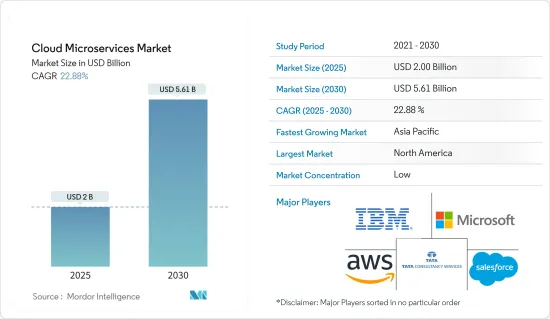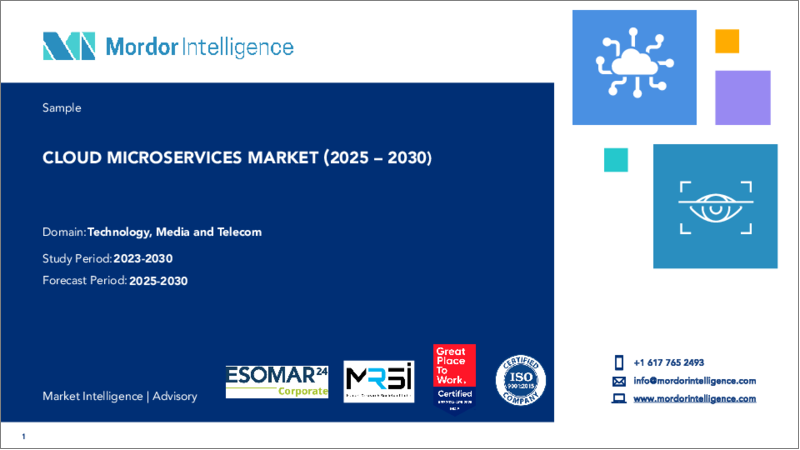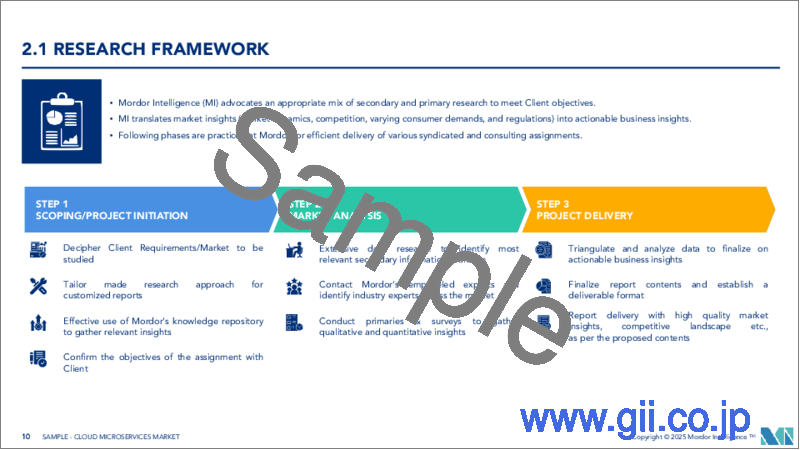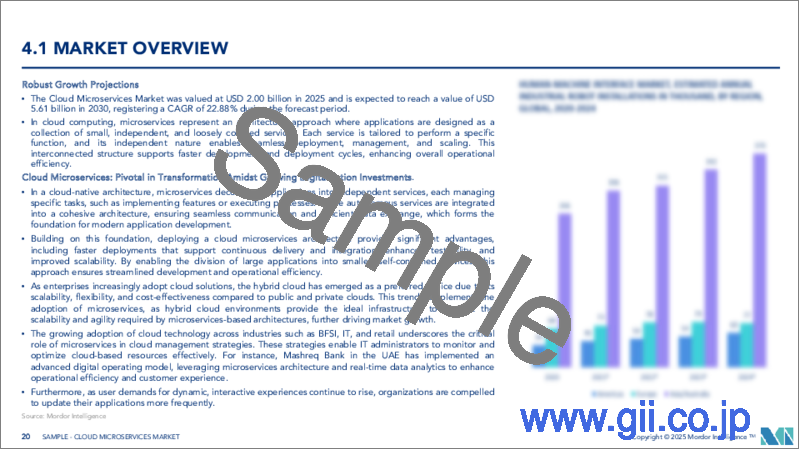|
|
市場調査レポート
商品コード
1642011
クラウドマイクロサービス:市場シェア分析、産業動向・統計、成長予測(2025年~2030年)Cloud Microservices - Market Share Analysis, Industry Trends & Statistics, Growth Forecasts (2025 - 2030) |
||||||
カスタマイズ可能
適宜更新あり
|
|||||||
| クラウドマイクロサービス:市場シェア分析、産業動向・統計、成長予測(2025年~2030年) |
|
出版日: 2025年01月05日
発行: Mordor Intelligence
ページ情報: 英文 120 Pages
納期: 2~3営業日
|
全表示
- 概要
- 目次
クラウドマイクロサービスの市場規模は、2025年に20億米ドルと推定され、予測期間中(2025~2030年)のCAGRは22.88%で、2030年には56億1,000万米ドルに達すると予測されます。

Kubernetesの普及が進むにつれて、企業はKubernetesを導入するだけでは不十分であることに気づき始めると予想されます。また、プロセス、ツール、アーキテクチャのあらゆる面を変更する可能性が高いです。Kubernetesは、全社的な変化を大きく後押しする可能性が高いです。Kubernetesはコンテナを管理する優れた方法を提供し、マイクロサービスアーキテクチャを企業規模で実用化します。
主なハイライト
- COVID-19の発生により、クラウドに対する世界の需要が増加しました。このため、クラウド・マイクロサービスは昨年末まで大きな影響を受けていました。労働力不足や遠隔監視の必要性から、クラウドサービスのニーズが高まっています。
- マイクロサービスアーキテクチャの普及は、アプリケーションをより小さなコンポーネントに分割することを促すため、市場を牽引しています。変更の適用が容易になります。このようなコンポーネントを導入しても、コードベースの大部分に影響を与えることはないです。軽量コンテナ・デプロイメントを使用するクラウドネイティブ・アプリケーションでは、このようなアーキテクチャ・スタイルが採用されるのが標準的です。多数のサービス、分散化された継続的デリバリー、DevOpsがその理由です。
- 現在、多くの企業がクラウド導入のさまざまな段階にあるため、さまざまなエンドユーザー業界におけるハイブリッド・クラウドの採用が市場を牽引しています。ハイブリッド・クラウドは、新しい製品やビジネスモデルを模索するための最大限の柔軟性を提供します。IT部門の役割が大きくなるにつれ、データセンターへの負荷も増大しています。コンピューティングやストレージのアップグレードに投資するのはコストがかかるが、ハイブリッド・クラウド・アプリケーションは費用対効果が高く、市場を牽引しています。
- BFSI、IT、小売、その他さまざまな業界でクラウド技術の採用が拡大していることが、クラウド・マイクロサービス市場の成長を後押ししています。クラウドマイクロサービスは、IT管理者がクラウドベースのリソースの運用状況を確認できるようにする、全体的なクラウド管理戦略の重要な役割を担っています。例えば、アラブ首長国連邦を拠点とするMashreq Bankは、先進的なデジタル・オペレーティング・モデルを採用し、マイクロサービス・アーキテクチャを活用し、分析にリアルタイム・データを活用しています。
- セキュリティとコンプライアンスの問題が、市場の成長を抑制しています。コンテナはより多くのソフトウェア開発環境を構築できるが、コンプライアンスに影響する新たなセキュリティリスクをもたらします。サイバー攻撃者は、クラウドアーキテクチャの権限設定内部の脆弱性を利用して、機密データサービスにアクセスすることができます。
クラウドマイクロサービスの市場動向
大きな成長が期待される製造セクター
- インテリジェント技術の進歩により、従来のオートメーション・ピラミッドが解消され、製造業ではマイクロサービス・クラウドの需要が増加しています。さらに、製造業のITはサービス指向とアプリ指向に移行しています。
- AWS(Amazon Web Services)の従量課金型マイクロサービスとサーバーレス・コンピューティング・モデルは、最小限の先行投資とほぼ無制限のオンデマンド容量で、コネクテッド製造工場やスマート製品プログラムの運営コストを削減します。
- 「クラウド・ネットワーク・マニュファクチャリング」は、製造企業が情報技術(IT)サポートとコンピュータ支援能力なしでは競争市場で生き残れないかもしれないことに気づいたため、ビジネスに新しい方法を提供します。マイクロソフトは製造業にとって圧倒的なコア技術サプライヤーであり、製造業者にOPC(オープンプラットフォーム通信)UA対応マシンのデジタルツインを提供し、セキュリティと認証管理を大幅に強化します。ここで顧客は、Azure上で動作するマイクロサービスを使って、OPCツインをクラウドから直接制御・管理することができます。
- ドイツの多国籍コングロマリットであるThyssenKrupp社は、IoT技術を利用して、自社のエレベーターをマイクロサービス・クラウドに接続しました。エレベーターのセンサーから収集されたデータにより、アルゴリズムが情報を処理し、エレベーターが故障する前にメンテナンスが必要な時期を予測します。この予測メンテナンスは拡張現実によってさらに強化され、エレベーター技術者はマイクロソフトのHoloLensを活用することで、現場にいながら専門家からハンズフリーで遠隔指示を受けることができます。
北米が最大の市場シェアを占める
- 先端技術の導入が進んでいるため、この地域は高い市場シェアを獲得しています。さらに、金融、eコマース、旅行サービスなどでマイクロサービスアーキテクチャが採用され、北米企業の需要が高まっています。マイクロサービス・アーキテクチャは、情報やデータをコスト効率よく保存し、俊敏性、効率性、拡張性を高めるのに役立ちます。
- ITUによると、カナダで支出されるデジタルトランスフォーメーション技術とサービスは、コグニティブ/人工知能(AI)システム、IoT、次世代セキュリティ、拡張現実や仮想現実、3Dプリンティング、ロボット工学などの新興技術への投資によって維持され、クラウドマイクロサービスを推進する160億米ドルを超えるとみられています。
- ウォルマート・カナダは、ソフトウェア・アーキテクチャをマイクロサービスにリファクタリングしました。1分あたり600万ページビューを処理できなかった同社は、一晩でコンバージョン率が大幅に向上し、即座に成果を実感しました。ダウンタイムも最小限に抑えられ、同社は高価なコモディティ・ハードウェアをより安価な仮想x86サーバーに置き換えることができるため、全体として20~50%のコスト削減を実現しました。これは、この分野におけるクラウド・マイクロサービスの需要を示しています。
- 米国では、IBM Cloud FunctionsとCloud鋳造によるマイクロサービスが、ストアフロントのショッピング・アプリケーションを展開しています。これは、顧客が購入し、レビューコメントを追加することができるアンティークコンピューティングデバイスのカタログを表示し、市場の成長を増加させる。
クラウドマイクロサービス業界の概要
クラウドマイクロサービス市場は細分化されています。主要企業は、パブリッククラウド、プライベートクラウド、ハイブリッドクラウドといった複数の展開モードにわたって、新製品の発売、パートナーシップ、買収など、さまざまな戦略を駆使しています。これは、この市場での足跡を増やすことで、長期的な持続に役立っています。Amazon Web Services Inc.、Microsoft Corporation、IBM Corporationなどが主なプレーヤーです。同市場における現在の進展は以下の通り:
- 2022年1月-EHSソフトウェアとコンテンツの大手プロバイダーであるRed-on-line社は、EHSプラットフォーム・ソリューションの大手であるGutwinski Management GmbH社を買収しました。この買収により、顧客ポートフォリオを深く補完する製品が誕生し、世界中のさらに多くの顧客が製品とサービスを利用できるようになります。
- Analytics AutomationのAlteryx, Inc.は、クラウドファーストの機能を提供するTrifactaを買収しました。この買収により、Alteryxは大企業に統合されたエンドツーエンド、ローコード/ノーコードのアナリティクス自動化プラットフォームをクラウドで提供するユニークな立場になります。また、データ分析チーム、IT/データエンジニアリングチーム、ビジネスユーザーといった企業全体のニーズに応えることができるようになります。
その他の特典:
- エクセル形式の市場予測(ME)シート
- 3ヶ月間のアナリスト・サポート
目次
第1章 イントロダクション
- 調査の前提条件と市場定義
- 調査範囲
第2章 調査手法
第3章 エグゼクティブサマリー
第4章 市場力学
- 市場概要
- 市場促進要因と市場抑制要因のイントロダクション
- 市場促進要因
- マイクロサービスアーキテクチャの普及
- 様々なエンドユーザー産業におけるハイブリッドクラウドの採用
- 市場抑制要因
- セキュリティとコンプライアンス
- 業界のバリューチェーン分析
- 業界の魅力度-ポーターのファイブフォース分析
- 供給企業の交渉力
- 買い手/消費者の交渉力
- 新規参入業者の脅威
- 代替品の脅威
- 競争企業間の敵対関係の強さ
第5章 COVID-19がクラウドマイクロサービス市場に与える影響分析
第6章 市場セグメンテーション
- 展開モード別
- プラットフォーム
- サービス別
- 企業規模別
- 中小企業
- 大企業
- エンドユーザー業界別
- BFSI
- 小売
- eコマース
- 製造業
- 通信業界
- ITおよびIT企業
- ヘルスケア
- その他エンドユーザー産業
- 地域別
- 北米
- 欧州
- アジア太平洋
- ラテンアメリカ
- 中東・アフリカ
第7章 競合情勢
- 企業プロファイル
- Amazon Web Services Inc.
- Microsoft Corporation
- IBM Corporation
- Salesforce.com Inc.
- Tata Consultancy Services Limited
- Broadcom Inc.(CA Technologies)
- VMware Inc.(Pivotal Software Inc.)
- Infosys Ltd
- Oracle Corporation
- NGINX Inc.
- Syntel Inc.
- Idexcel Inc.
- RapidValue IT Services Private Limited
第8章 投資分析
第9章 市場機会と今後の動向
The Cloud Microservices Market size is estimated at USD 2.00 billion in 2025, and is expected to reach USD 5.61 billion by 2030, at a CAGR of 22.88% during the forecast period (2025-2030).

As Kubernetes' adoption grows, companies are expected to start realizing that it is not enough to adopt it. They will also likely change all aspects of their processes, tools, and architecture. Kubernetes is likely to be a big push for profound company-wide changes. It provides an excellent way to manage containers and makes microservices architectures practical at an enterprise scale.
Key Highlights
- Owing to the COVID-19 outbreak, the global demand for the cloud increased. Due to this, the cloud microservices were severely influenced until last year's end. The need for cloud services is growing due to a lack of workforce and remote monitoring requirements.
- The microservices architecture proliferation is driving the market, as it encourages breaking the application into smaller components. It becomes easy to apply changes. Deploying such components does not end up impacting a large part of the codebase. It is standard for such an architectural style to be adopted for cloud-native applications using lightweight container deployment. It is because of the large number of services, decentralized continuous delivery, and DevOps.
- Hybrid cloud adoption across various end-user industries is driving the market, as many enterprises are currently in different stages of cloud adoption. The hybrid cloud gives them maximum flexibility to explore new products and business models. As IT's role grew, the load on the data center was evolving. Investing money in upgrading computing or storage is costly, but hybrid cloud applications are cost-effective and drive the market.
- The growing cloud technology adoption across industries such as BFSI, IT, retail, and various others is augmenting the cloud microservices market growth. It is a significant part of an overall cloud management strategy, enabling IT administrators to review the cloud-based resources' operational status. For instance, United Arab Emirates-based Mashreq Bank adopted an advanced digital operating model, utilized microservices architecture, and leveraged real-time data for analytics.
- Security and compliance issues are restraining the market from witnessing growth. The container can create more software development environments, but it leads to new security risks that affect compliance. Cyber attackers can benefit from vulnerabilities inside the permission settings of cloud architecture to reach sensitive data services.
Cloud Microservices Market Trends
Manufacturing Sector Expected to Register a Significant Growth
- Due to intelligent technology advancement, the microservice cloud demand is increasing in the manufacturing sector as the traditional automation pyramid dissolves. Moreover, manufacturing IT is moving toward service orientation and app orientation.
- AWS (Amazon Web Services) pay-as-you-go microservices and serverless computing models reduce the cost of running the connected manufacturing plant or smart product programs with minimum upfront investment and nearly unlimited on-demand capacity.
- "Cloud network manufacturing" provides a new way for business, as manufacturing companies discovered they may not survive in the competitive market without Information Technology (IT) support and computer-aided capabilities. Microsoft is the dominant core technology supplier to the manufacturing industry, which provides manufacturers a digital twin of their OPC (Open platform communication) UA-enabled machines and significantly enhances security and certification management. Here, customers can control and manage their OPC twins directly from the cloud using microservices running on Azure.
- ThyssenKrupp, a German multinational conglomerate, drew upon IoT technology to connect its elevators to the microservice cloud. The data collected from an elevator's sensors allows algorithms to process information and predict when maintenance is required before the elevator breaks down. This predictive maintenance is further enhanced by augmented reality, with elevator technicians utilizing Microsoft HoloLens to receive remote, hands-free instructions from experts while in the field.
North America to Account for Largest Market Share
- Due to the increasingly advanced technologies adoption, this region is gaining a high market share. Moreover, there is a growing demand from North American companies, as they have adopted microservices architecture in financial, e-commerce, and travel services. It helps store information and data cost-effectively and increases agility, efficiency, and scalability.
- As per ITU, digital Transformation technologies and services spent in Canada are set to exceed USD 16 billion sustained by the investment in emerging technologies, such as cognitive/artificial intelligence (AI) systems, IoT, next-generation security, augmented reality or virtual reality, 3D printing, and robotics, driving the cloud microservices.
- Walmart Canada refactored its software architecture to microservices. The company, which could not handle the 6 million page views per minute it was getting, realized instant results with a significant increase in its conversion rate overnight. The downtime was also minimized, and the company can replace expensive commodity hardware with cheaper virtual x86 servers, resulting in overall cost savings between 20 and 50 %. It gives demand for cloud microservice in this sector.
- In the United States, Microservices with IBM Cloud Functions and Cloud Foundry deploys a storefront shopping application. It displays an antique computing devices catalog where customers can make purchases and add review comments, increasing the market's growth.
Cloud Microservices Industry Overview
The cloud microservices market is fragmented. The major players have used various strategies, such as new product launches, partnerships, acquisitions, and others, across multiple deployment modes, like public, private, and hybrid cloud. It helps increase their footprints in this market to sustain the long run. Amazon Web Services Inc., Microsoft Corporation, IBM Corporation, etc., are the primary players. Current advancements in the market are:
- January 2022 - Red-on-line, a leading EHS software and content provider, acquired Gutwinski Management GmbH, a leading EHS platform solution. The acquisition will create a profoundly complementary client portfolio product and have an opportunity to make products and services available to even more customers worldwide.
- Alteryx, Inc., the Analytics Automation company, acquired Trifacta, which offers cloud-first capabilities to help enterprises drive their analytics transformation at scale. With this acquisition, Alteryx will be uniquely positioned to provide large enterprises with an integrated end-to-end, low-code/no-code analytics automation platform in the cloud. It will also serve the needs of the entire enterprise: data analytics teams, IT/data engineering teams, and business users.
Additional Benefits:
- The market estimate (ME) sheet in Excel format
- 3 months of analyst support
TABLE OF CONTENTS
1 INTRODUCTION
- 1.1 Study Assumptions and Market Definition
- 1.2 Scope of the Study
2 RESEARCH METHODOLOGY
3 EXECUTIVE SUMMARY
4 MARKET DYNAMICS
- 4.1 Market Overview
- 4.2 Introduction to Market Drivers and Restraints
- 4.3 Market Drivers
- 4.3.1 Proliferation of the Microservices Architecture
- 4.3.2 Adoption of Hybrid Cloud Across Various End-user Industries
- 4.4 Market Restraints
- 4.4.1 Security and Compliance
- 4.5 Industry Value Chain Analysis
- 4.6 Industry Attractiveness - Porter's Five Forces Analysis
- 4.6.1 Bargaining Power of Suppliers
- 4.6.2 Bargaining Power of Buyers/Consumers
- 4.6.3 Threat of New Entrants
- 4.6.4 Threat of Substitute Products
- 4.6.5 Intensity of Competitive Rivalry
5 Analysis on the impact of COVID-19 on the Cloud Microservices Market
6 MARKET SEGMENTATION
- 6.1 By Deployment Mode
- 6.1.1 Platforms
- 6.1.2 Service
- 6.2 By Enterprise Size
- 6.2.1 Small and Medium Enterprises
- 6.2.2 Large Enterprises
- 6.3 By End-user Industry
- 6.3.1 BFSI
- 6.3.2 Retail
- 6.3.3 E-commerce
- 6.3.4 Manufacturing
- 6.3.5 Telecommunications
- 6.3.6 IT and ITes
- 6.3.7 Healthcare
- 6.3.8 Other End-user Industries
- 6.4 By Geography
- 6.4.1 North America
- 6.4.2 Europe
- 6.4.3 Asia Pacific
- 6.4.4 Latin America
- 6.4.5 Middle East and Africa
7 COMPETITIVE LANDSCAPE
- 7.1 Company Profiles
- 7.1.1 Amazon Web Services Inc.
- 7.1.2 Microsoft Corporation
- 7.1.3 IBM Corporation
- 7.1.4 Salesforce.com Inc.
- 7.1.5 Tata Consultancy Services Limited
- 7.1.6 Broadcom Inc. (CA Technologies)
- 7.1.7 VMware Inc. (Pivotal Software Inc.)
- 7.1.8 Infosys Ltd
- 7.1.9 Oracle Corporation
- 7.1.10 NGINX Inc.
- 7.1.11 Syntel Inc.
- 7.1.12 Idexcel Inc.
- 7.1.13 RapidValue IT Services Private Limited






